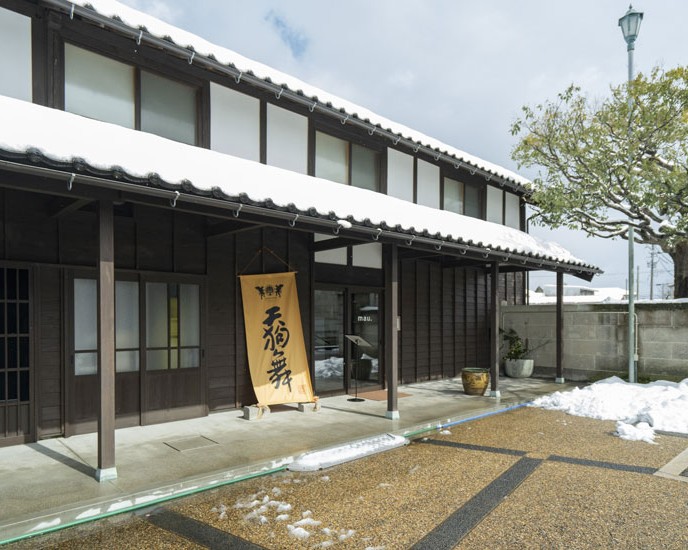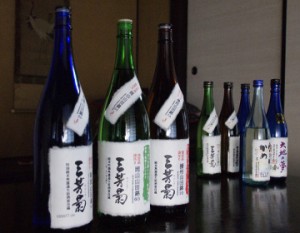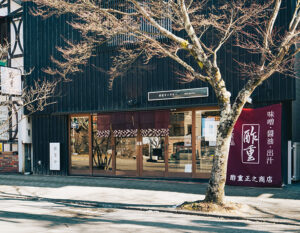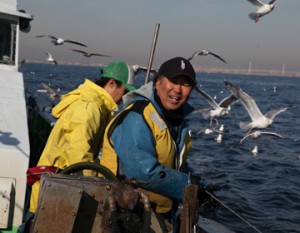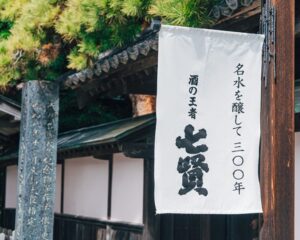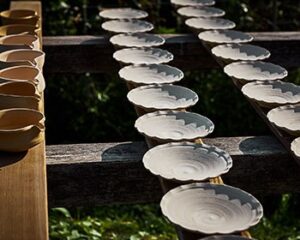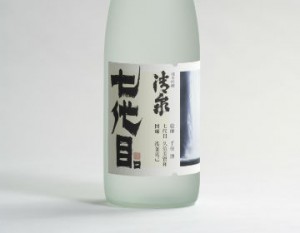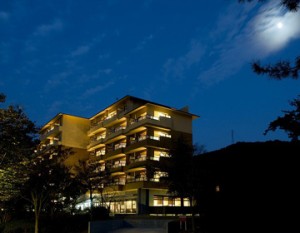Sakurada Sake Brewery, located in Suzu City, Ishikawa Prefecture, suffered damage from the Noto Peninsula Earthquake of 2024, which completely destroyed the brewery. The brewery’s head brewer, Hiroyoshi Sakurada, once considered shutting down the business, but many encouraging voices pushed him back and he decided to rebuild. He borrowed facilities from the Shata Brewery in Hakusan City, Ishikawa Prefecture, about 150 km away, and resumed sake brewing in the form of a “joint brewery.
Sake produced in the harsh yet beautiful Noto climate

Suzu City is located at the tip of the Noto Peninsula, which juts out into the Sea of Japan. The harsh natural environment and the honest activities of the people have shaped the beautiful scenery of this “farthest” city.
Takojima, which has long flourished as a fishing town, is one of the areas where Suzu’s history and culture remain strong. Sakurada Sake Brewery is a small sake brewery that has been brewing sake in this town since the Taisho era. Their representative brands are “Taikei” and “Hatsuzakura. Both have long been loved by local fishermen. After a long day of fishing, this sweet sake is perfect for a tired body. Mr. Hirokatsu Sakurada, who is both the brewer and the toji (master brewer), has continued to brew “sake that fishermen on Tako-jima can drink every day and not get tired of it.
Sake brewery completely destroyed by Noto Peninsula earthquake.
The Noto Peninsula earthquake occurred on January 1, 2024. Takojima, near the epicenter of the quake, was hit by a powerful tremor, and the Sakurada Sake Brewery and store were completely destroyed. Mr. Sakurada and his family were safe, but he said he was prepared to “close down the business” when he saw the collapsed brewery. The previous year, there had been an earthquake with an intensity 6 upper on the Japanese seismic scale, and they had just finished repairing the broken mud walls. They had just finished repairing the damaged mud walls. They were just about to start sake production at the beginning of the New Year with a fresh start.
In mid-January, an event lit a fire in the heart of Mr. Sakurada, who had been in a state of despair. Volunteers removed sake rice that had been buried in the rubble. Seeing the sake rice in one piece, Mr. Sakurada decided, “Let’s make sake again. He immediately contacted his friend of 30 years, Kazunari Kurumata, the eighth generation of the Kurumata Shuzo brewery, and asked for his cooperation.
Shata Shuzo, a long-established brewery known for its Yamahai brewing method

About 150 km south of Suzu City, Kurumata Brewery is located in the middle of the Kaga Plain in Hakusan City, Ishikawa Prefecture. Kurumada Shuzo, founded in 1823, is a long-established brewery located in the middle of the Kaga Plain in Hakusan City, Ishikawa Prefecture. Its representative brand is “Tengumai,” a famous sake brewed with water from Mt. Kurumada Shuzo’s signature “Yamahai brewing” is a traditional method of sake mother fermentation in which the brewery’s own lactic acid bacteria are used to slowly ferment the sake over a long period of time. The process takes a lot of time and effort to brew a full-bodied, richly flavored sake.
At the Kura Master Sake Competition 2024 held in Paris, France, Tengu Mai Yamahai Junmai Sake won both the Jury Prize in the Classic Hashi Moto category and the Alliance Gastronomy Prize, and is highly regarded worldwide.
Providing equipment and supporting sake brewing through “Kyodo Brewing

When I called him right after the earthquake to see if I could do anything to help, he said he had given up,” says Kurumata. That is why he was happy to hear Mr. Sakurada’s determination to “make sake again. As friends and fellow sake brewers, they set out together on the road to rebuilding the Sakurada Brewery.

The brewery workers were working hard amidst the steam rising from the steaming rice. Among them was Mr. Sakurada. His face is cheerful in the lively brewery.
The joint brewing project, which began in March 2024, is being carried out using Shata Shuzo’s facilities, and some of the finished sake is being sold through Shata Shuzo’s distribution channels. Until the new brewery is rebuilt in Suzu, the brewery plans to brew sake with the help of the brewers at Kurumata Brewery.
Pursuing the taste of Noto, his hometown

The environment, including water, temperature, and ventilation, affects the taste and aroma of sake. It is said that the “kuraguse” or “brewery habit” gives each brewery its own unique flavor.
The taste certainly changes because of the different environment. But the aftertaste is still our sake,” says Sakurada. In addition to the three-stage brewing process, in which koji and steamed rice are brewed in three separate batches, the fourth and final stage uses glutinous rice. This process produces the sweet taste favored by fishermen on Takojima, but it is not the only deciding factor. The sake brewed with the faces of the people of his hometown, Suzu, in mind has a strong, punchy flavor. Mr. Sakurada told us that the individuality of sake comes not only from the environment and techniques used, but also from the brewer’s passion.
What Joint Brewing Has Brought to the Two Breweries
Mr. Sakurada also participates in Kurumada Shuzo’s sake brewing as a brewer. Every day he comes into contact with the know-how of the brewery, he says, “is full of new discoveries. The techniques, equipment, and attitude toward sake brewing are all new to him.
One of the most important things he has learned is koji making. At Kurumada Brewery, they focus on developing koji that brings out the flavor of the rice and creates a three-dimensional taste. Mr. Sakurada hopes to incorporate this koji making technique into his rebuilt brewery. I want to make good sake with the essence of the Kurumata style,” he said. I want to make good sake with the essence of the Kurumata style, and it has become my dream to have everyone at the Kurumata Brewery drink it. Mr. Sakurada smiles as he says this.
Kurumata, on the other hand, says the joint brewing has renewed his passion for sake brewing. People in Noto don’t look down. Mr. Sakurada is a typical example. With the sake industry in the doldrums, we too must look forward and move forward. I always talk about this with my employees. Kurumata-san says that such a desire should have a positive impact on the quality of sake as well.
Preserving the Sake Brewing Culture that Gave Birth to the Noto Toji Brewery

Although Kurumata Brewery suffered only minor direct damage from the earthquake, the company is feeling a great sense of crisis in terms of “sake brewing leaders.
At Kurumata Brewery, the brewery’s head brewer and the “Noto Toji” have been brewing sake together for generations. The toji is the chief manager of a group of sake brewing craftsmen. It is also an important position that determines the taste of sake. The people of Noto have long visited sake breweries across the country to make sake during the off-season, and the sake brewed by these people was described as having a “rich and gorgeous flavor. Today, many Noto toji are still active in sake breweries across the country, and their skills are considered to be among the best in Japan.
The Noto Peninsula earthquake not only caused damage to nine of the 11 breweries in Noto, with two half destroyed, but also dealt a serious blow to the livelihood of the Noto toji and brewery workers. Not a few people lost their homes and moved to other places.
The loss of human resources involved in sake brewing from Noto means the loss of the sake brewing culture centered on the Noto toji. How do we carry on the traditional sake brewing culture? I think it is a big issue,” says Kurumata. Kurumata believes that it is the mission of sake breweries in Ishikawa Prefecture to protect the livelihood of Noto-born toji and brewers, to train their successors, and to promote “Noto Toji sake” both in Japan and abroad.
Father and Son Join Forces to Rebuild Sake Brewery

On the other hand, there is a bright note. Mr. Sakurada’s eldest son, Shintaro, has decided to take over the family business. He was inspired by his father’s determination to overcome hardships and rise once again, and said, “Okay, let’s give it a shot.
While studying brewing at the Tokyo University of Agriculture, Shintaro took time off to live at Kurumata Brewery and work with his father on a joint brewing project. He has been familiar with the brewing process since he was a child, but he says he has learned a lot from his involvement in the various operations at Kurumata Brewery. He looks forward with great strength, saying, “I would like to take the attention that the earthquake has brought to our brewery as an opportunity.
New Sake for Noto’s Future

On a more positive note, a new generation of sake brewers has begun in 2025, led by Shintaro and Keiichiro Kurumata, the eldest son of Kazunari Kurumata, who will become the 9th generation brewer. The concept is “sake that can be enjoyed by the younger generation. In addition, the two breweries will collaborate to brew a sake called “Daikei x Tengu Mai,” with the major goal of “making people aware of Noto Sakurada Brewery’s ‘Daikei’.
The project involves not only the two incoming brewers, but also the young brewers of Kurumata Shuzo. Sake brewing is underway, making full use of the young sensibilities of the brewers.
For the ingredients, the brewery chose “Hyakumangoku no Shiro,” an original sake rice from Ishikawa Prefecture, and “Kanazawa yeast,” which was born in Ishikawa Prefecture. Keiichiro says, “We decided to brew all Ishikawa sake in order to promote the attractiveness of Ishikawa and Noto. He hopes to broaden the base of people who enjoy sake by creating a fresh taste that combines umami and acidity.
A modern sake made with traditional techniques. The sake is named “Tsumugu Noto” (Tsumugi for Noto). A new future that began with a joint brewing project. The challenge by the young brewers is the first step toward creating a new identity for Noto.
Brewing Hope for the Future through Joint Brewing
The joint brewing project that started with sake rice rescued from the rubble has entered its second season in 2025. This year, Sakurada Brewery is using sake rice produced in Suzu City, which was procured by Kurumata Brewery, as part of the ingredients. Mr. Sakurada has high hopes for the evolving flavor of this year’s sake, saying, “I think the kindness of Shata Brewery in supporting us in this way will show in the flavor of this year’s sake.
The joint brewing project, which initially started with the goal of rebuilding Sakurada Brewery, is now entering a new phase of “evolving Noto’s sake,” with young brewers taking on new challenges beyond the boundaries of their breweries. Both Sakurada and Shata breweries have one goal in mind. The two breweries, Sakurada and Shata, have one goal: to protect the sake brewing culture of Ishikawa Prefecture, which has been nurtured together with the Noto toji, and to further refine it to connect it to the future. From joint brewing for support to joint brewing to brew the future together. Mr. Sakurada and Mr. Shata hope to deliver sake with a taste that inspires hope to many people.



